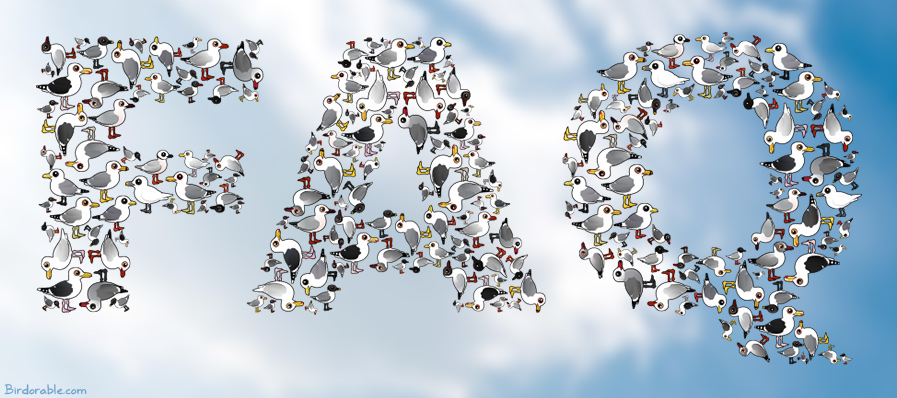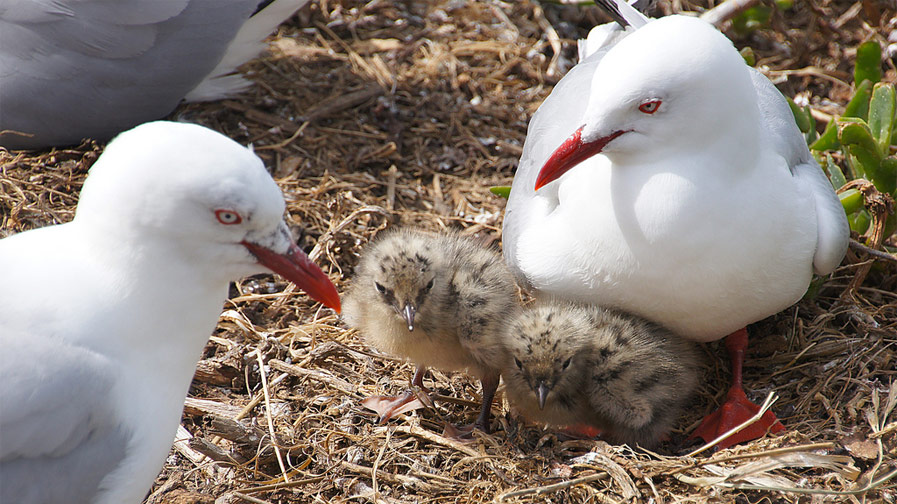More Gull Frequently Asked Questions

When we had our first Gull Week in 2015, we answered some Frequently Asked Questions About Gulls. Today we're going to answer a few more fun FAQs about the species in this family of seabirds!
What do gulls eat? Are gulls carnivores? What do gulls drink?
Gulls tend to be opportunistic omnivores. They'll take every chance to eat almost anything! Gulls feed on fish and other marine animals. They will eat insects, worms, eggs, and small land animals. Gulls may also feed on carrion and garbage, other birds, and plant matter like seeds and fruit. As far as drinking, gulls are able to drink sea water. A special gland helps them excrete the salt before it reaches the kidneys.
What do gulls do in winter? When do gulls migrate?
Most gulls migrate between wintering grounds and breeding territory. After mating season is complete, they move to warmer climates. The specific timing of this depends on their breeding calendar. Migration distances range from the Franklin's Gull's yearly trek from Canada to South America, to species that simply disperse to the coast from more inland breeding grounds.
What are baby gulls like?
Most baby gulls have downy feathers when they hatch. In most gull species, chicks are precocial (or semi-precocial), meaning that they are relatively mobile and can leave the nesting site within a short time of hatching. Ring-billed Gulls fully leave their nest by 4 days of age. Baby Herring Gulls remain close to their nest site for the first week of life. Young gulls are typically dependent on their parents or other adult gulls for food until they fully fledge.

Where do gulls go at night?
Most species of gull are diurnal, meaning they are awake during the day and at rest during the night. Gulls typically like to roost either on the water, or along beaches, dunes, or offshore islands. Sleeping on the water is only preferred when the water is calm. The exception to this is the Swallow-tailed Gull, the world's only nocturnal gull species. Instead of resting at night, they are on the hunt for food.
How can you tell how old a gull is?
This is a great part of the challenge of gull identification. There is no simple answer that covers all gull species. Gulls go through different plumages as they reach adulthood and they also go through two yearly molts.
The number of years it takes a gull to reach its full adult plumage ranges from two years for smaller gulls to three or four years for larger birds. Gulls of different ages will have different plumages.
Gulls also go through molts each spring (to "alternate plumage") and fall (to "basic plumage"). During a molt, which may take place over several weeks, the bird may appear to be in between two plumages.
In addition to the changes in a gull's feather appearance, there are changes that may occur to their legs and bills. These may change color as they age or molt!
When you know the specifics of how a species of gull ages and molts, you may be able to tell if a gull is one, two, or three years old, or an adult aged four or older.
Are gulls protected?
Sometimes gulls are considered to be nuisance birds. Their level of protection varies from place to place. In the United States, native gulls are protected under the Migratory Bird Treaty Act. In the United Kingdom, they are protected under the Wildlife and Countryside Act 1981 and the Wildlife Order 1985 (Northern Ireland).
Do gulls sing?
In general, gulls are not known for their melodious voices. Their vocalizations are often brash and loud, part of the soundtrack of the beach in many locations. Their vocalizations are typically referred to as calls, with each species utilizing a variety of different calls for communicating things like finding (or begging for) food, warning off intruders, sounding a predator alarm to the colony, and other reasons. Different calls will also be used for pair-bonding and even during copulation. Chicks have different call sounds than adults.
See our previous post for more frequently asked questions about gulls.









Comments
Leave a comment
Thank you!